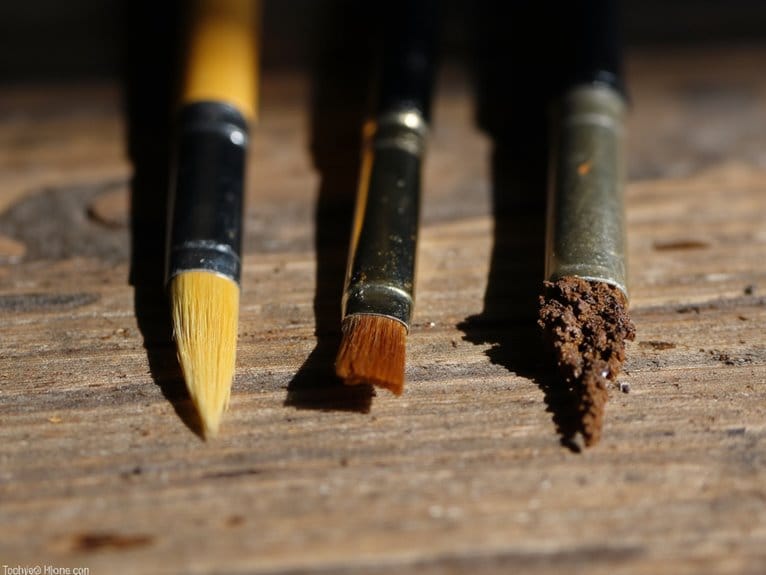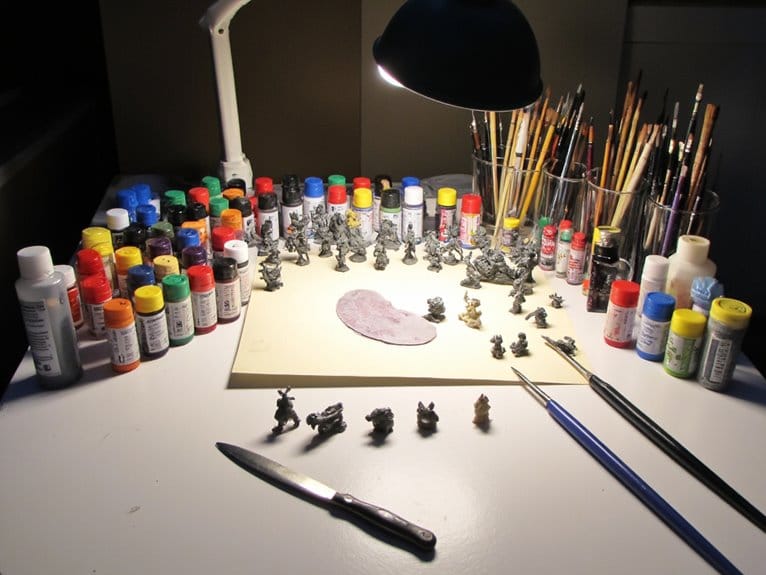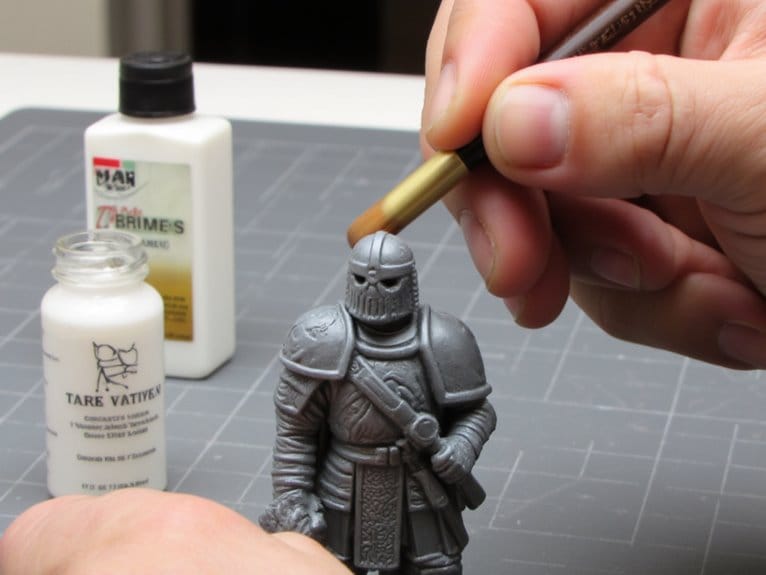We are supported by our audience. When you purchase through links on our site, we may earn an affiliate commission, at no extra cost for you. Learn more. Last update on 1st July 2025 / Images from Amazon Product Advertising API.
You’ll get dramatically different results depending on your choice: hot wire cutters excel at precise EPS foam cuts with smooth edges at 2.5-3 mm/sec speeds, while hot knives handle thicker XPS sections faster with 320W power capacity. Hot wire produces minimal debris and seals edges during cutting, but requires frequent wire replacement. Hot knives heat faster and work better on dense materials, though they leave rougher surfaces needing finishing. Your specific foam type and detail requirements will determine the best tool selection for maximum efficiency.
Notable Insights
- Hot wire cutters produce smoother edges with minimal debris, while hot knives heat faster but leave rougher surfaces requiring finishing.
- Hot wire excels at precise curved cuts and intricate detailing, while hot knives handle thicker foam sections efficiently in single passes.
- XPS foam offers better machinability and cleaner cuts, while EPS provides cost-effectiveness and superior sound absorption properties for terrain projects.
- Hot wire cutters achieve 2.5-3mm/sec cutting speeds with 25% less material waste, especially effective on low-density foams for detailed work.
- Hot knives are more intuitive and budget-friendly for beginners, while hot wire systems justify higher costs for professional precision requirements.
Understanding Hot Wire and Hot Knife Cutting Technologies
When you’re selecting foam cutting tools for terrain modeling, understanding the fundamental differences between hot wire and hot knife technologies will determine your project’s success.
Hot wire cutters use tensioned nichrome wire electrified at low voltage. The wire resists electricity, generating heat that melts foam on contact. You’ll achieve smooth, straight cuts ideal for creating precise contours when guided properly. You should adjust device output power for minimal wire temperature needed to ensure optimal cutting performance. Hot wires cut efficiently with minimal debris, making cleanup easier during terrain projects.
Tensioned nichrome wire generates precise heat through electrical resistance, melting foam for smooth, straight cuts in terrain modeling projects.
Hot knives employ heated metal blades powered by electricity. These cutting technologies cut by melting through foam, handling thicker sections in single passes. Hot knives heat faster and maintain consistent temperatures for dense materials.
Your tool selection depends on project requirements: hot wire excels at clean geometric cuts, while hot knives offer versatility for intricate shaping and detailed work.
Material Compatibility: EPS Vs XPS Foam Performance
Your choice of cutting tool matters, but the foam material itself determines your project’s final quality and longevity. Material properties differ significantly between EPS and XPS foams, affecting both cutting performance and terrain durability.
XPS delivers superior performance advantages through its closed-cell structure, providing better moisture resistance and thermal efficiency. Its enhanced machinability aspects produce cleaner cuts with finer detail retention. However, cost considerations favor EPS, which offers wider thickness options and lower pricing.
Key material compatibility factors include:
- Structural stability: XPS maintains dimensional consistency in humid conditions
- Weight differences: Both foams remain lightweight for terrain handling characteristics
- Application suitability: XPS excels in precision work requiring thinner profiles
- Cutting quality: XPS yields smoother edges with less dust production
- Durability: XPS resists moisture damage better than porous EPS
EPS foam demonstrates excellent sound absorption properties compared to XPS, making it beneficial for terrain projects where acoustic dampening is required. When using hot wire cutters, proper ventilation is essential to avoid inhaling fumes from melting foam during the cutting process.
Precision and Edge Quality Comparison
When you’re cutting foam for terrain projects, the smoothness and quality of your cut edges directly impact how professional your finished pieces will look.
Hot wire cutters produce exceptionally smooth edges by melting through foam cleanly, while hot knives often leave slightly rougher surfaces with melted residue that requires additional finishing work. Hot wire cutting also minimizes waste by sealing edges during the cutting process, resulting in less debris around your workspace.
Hot wire cutters operate using low electrical current that heats a fine wire to slice through foam without creating excessive mess throughout your work area. Professional models like the Hercules Hot Wire Foam Cutter Table are ideal for detailed projects like architectural models and gaming terrain.
You’ll need to evaluate whether your project demands the pristine edge quality that hot wire cutting delivers or if you can accept the faster but less refined results from hot knife methods.
Cut Smoothness Differences
Although both hot wire cutters and hot knives produce clean cuts through foam, the precision and edge quality they deliver differ markedly based on their cutting mechanisms and temperature control systems.
Hot knives excel in smoothness through controlled blade contact. Their heated blades operating at 90-150°C create sealed edges by gently softening foam surfaces. This sealing action prevents edge crumbling and reduces debris formation.
Hot wires melt through material using steady heat distribution. While they produce uniform cuts along straight paths, complex curves can result in slightly rougher textures. The hot wire technology leaves smooth edges without dust, making it particularly effective for creating clean finishes.
Key smoothness differences include:
- Hot knives leave smoother edges with minimal finishing requirements
- Hot wire cuts may feel stringy depending on wire quality
- Blade cutting techniques enable better manipulation of intricate outlines
- Wire tension affects smoothness on fine contours
- Hot knife edge treatments surpass wire cutting on varied foam densities
Edge Finishing Requirements
The quality of your foam cuts directly impacts how much additional work you’ll need to complete your terrain project.
Hot wire cutters typically produce edges requiring minimal post-processing when temperature and speed parameters are optimized. The melted surface creates naturally sealed edges with good edge durability for handling and assembly. However, you may need light sanding if the wire leaves compressed or slightly rough surfaces.
Hot knives generally demand more extensive finishing techniques due to blade thickness and heat distribution variability. While they create consistently sealed edges that resist fraying, blade flexibility can cause wandering cuts requiring correction.
You’ll often need additional smoothing or trimming to achieve professional results. Wire cutters excel when precision matters most, while knives work better for quick cuts where extensive finishing is acceptable.
Tool Design and Operational Features
Since foam cutting tools vary considerably in their design approaches, you’ll find two primary categories dominating the market: hot knives and hot wire systems. Each employs distinct cutting techniques and design elements that determine their operational effectiveness.
Hot knives feature heated blades operating at 320W power capacity, weighing 400-550g for portability. These tools use direct contact heating for fast penetration through EPS and XPS materials. You’ll operate them manually with interchangeable blades for varied cutting styles.
Hot knives deliver 320W power in portable 400-550g designs with interchangeable blades for versatile EPS and XPS cutting applications.
Hot wire systems utilize heated titanium alloy wire integrated into CNC-controlled frameworks.
Key design elements include:
- Control arms for precise wire positioning
- Tabletop with turntable for foam manipulation
- Computer-controlled automation for repeatability
- Wire melting action requiring minimal physical force
- Structural stability for complex three-dimensional cutting
Speed and Efficiency in Different Density Materials
When you’re cutting terrain foam, density directly impacts your tool’s performance and cutting speed.
Low-density foams like EPS allow hot wire cutters to maintain speeds around 2.5-3 mm/sec while producing clean, consistent cuts with minimal resistance.
High-density materials such as XPS polystyrene create more cutting resistance, requiring slower feed rates with hot wires but often work better with hot knives that can penetrate dense foam more efficiently.
Low Density Foam Performance
Working with low-density foams presents unique challenges that directly impact your cutting tool selection and project efficiency.
These soft, pliable materials require specific foam properties considerations to achieve clean cuts without compression or tearing. Your cutting techniques must account for the delicate nature of these materials.
Hot wire cutters consistently outperform hot knives in low-density applications:
- Speed advantage: Hot wire cutters operate 30-40% faster than hot knives
- Temperature consistency: Continuous heat source prevents material binding
- Precision control: Maintains smooth cuts through delicate foam structures
- Waste reduction: Clean cuts minimize material loss by up to 25%
- Energy efficiency: Lower operational costs during extended cutting sessions
The thermal characteristics of low-density foam respond better to hot wire’s consistent temperature profile, making it your ideal choice for terrain modeling projects.
High Density Cutting Speed
Although high-density foams present greater resistance to cutting tools, they reveal distinct performance patterns that’ll determine your project timeline and quality outcomes.
Hot wire cutters maintain speeds around 2.5-3 mm per second in dense materials, requiring careful voltage and tension adjustments to prevent wire drag. You’ll need slower feed rates compared to low-density foam, but the melting action still outperforms mechanical cutting techniques considerably.
Hot knives adapt quickly to density challenges through variable temperature controls, heating within 4-6 seconds for rapid preparation. Dense materials demand steadier manual control and slightly reduced speeds, but you’ll achieve superior edge sealing.
Both tools require iterative speed and heat adjustments in high-density applications. Monitor exit quality closely to optimize performance and minimize defects like burning or incomplete cuts.
Maintenance Requirements and Tool Durability
Two critical factors determine your foam cutting operation’s long-term success: establishing consistent maintenance routines and understanding each tool’s durability characteristics.
Hot wire cutters demand frequent wire replacements when nichrome elements oxidize or break. You’ll need to wipe down surfaces with non-abrasive cloths and check wire tension regularly to prevent snapping injuries.
Hot knives require daily blade sharpness inspections and heating element monitoring for even heat distribution.
Essential maintenance routines include:
- Clean foam debris after each session to reduce fire hazards
- Schedule cooling periods during prolonged use to prevent overheating
- Verify electrical connections and insulation integrity regularly
- Use compressed air to remove particles from tight crevices
- Store tools in temperature-stable, dry environments
Tool longevity varies greatly: hot knife frames last several years with proper blade replacement, while hot wire segments need frequent replacement despite durable frames.
Choosing the Right Cutter for Your Terrain Project
Success in foam cutting depends heavily on matching your cutter type to your specific terrain project requirements. Your tool selection should prioritize foam density and project complexity.
Choose hot wire cutters for EPS foam and intricate detailing work requiring curved cuts and fine edges. Their thin heated wire delivers superior precision for modular terrain pieces.
Hot wire cutters excel at precision work, delivering clean curved cuts and fine edges essential for detailed modular terrain construction.
Select hot knives for denser XPS foam blocks and straightforward cutting tasks. These tools handle thicker materials more effectively with their robust heated blades.
Consider your skill level when evaluating cutting techniques. Hot knives offer intuitive blade-like operation, while hot wire cutters require temperature control and wire tension adjustments.
Budget constraints also influence decisions. Hot knives provide cost-effective solutions for simple projects, whereas hot wire cutters justify higher investment for detailed terrain work.
Many professional hot knife systems include adjustable heat settings that allow you to optimize cutting performance across different foam densities and material types.
On a final note
You’ll achieve better results by matching your cutting tool to your specific terrain requirements. Hot wire cutters excel for straight cuts and large-volume work with consistent density foams. Hot knife systems provide superior versatility for detailed sculpting and mixed-density materials. Consider your project scale, foam type, and required precision level. Both tools offer distinct advantages—your choice depends on whether you prioritize speed and volume or detail and flexibility in your terrain construction workflow.



